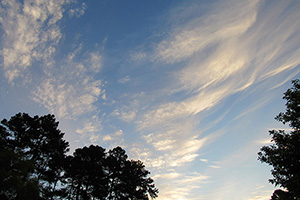Eclipsed By None, NIEHS Employees Look To the Skies
By Bill Willis and Bill Steinmetz
September 13, 2017

On August 21, 2017, the morning sky gave no indication of what was to happen later in the day, a special cosmic display. The event would have a noticeable effect on both human and wildlife activities. While some employees left the Triangle to witness and record the total eclipse, others gathered on the patios in the Research Triangle Park with eyes to the skies.
What did our employees experience during the eclipse?
Monday afternoon was a special time for NIEHS employees as they gathered around the Institute to gaze skyward at the eclipse. Although the eclipse was only about 92% here, it was still spectacular and satisfying to all participating. Employees used cardboard and cereal-box periscopes, pin-hole projectors, x-ray sheet interceptors and colander holders as well as special solar viewing glasses to safely view the eclipse. Employees willingly shared their homemade indirect view-masters with each other.
They got a chance of a lifetime to witness and document an eclipse that crossed 14 states, 2496 miles, in 90.7 minutes at an average speed of 1651 mph. Nature also got involved as red oak trees, trellises, and plants joined in the show, displaying various ways to make multiple images. The next total eclipse across the US will be in April 2024.

The local temperature that morning was 72oF under partly cloudy skies, but by lunchtime was 91oF under scattered clouds with SSE winds of 6-8 mph. At the height of the eclipse, winds decreased to 3.5 mph, the temperature to 88oF and there was a drop in building 110’s solar power production. The changes were greater closer to the path of totality.
What did the wildlife experience during the eclipse?
A total solar eclipse can change the normal behavior of farm animals and birds even though it’s only a very short period. We observed geese on campus to see if the partial eclipse would impact their afternoon behavior.
As 1:15 p.m. approached, thirty Canada Geese were eating grass on the lawn between the 101oC and Discovery Lake. They were busily moving around and eating which was normal for them. However, as the moon blocked more and more of the sun, they moved toward the lake. They entered the water, but instead of swimming off, stayed quietly huddled next to the bank. This behavior was a deviation from the norm, and the geese remained close to the banks until most of the sun could be seen again at 3:30 p.m.
Employees have shared some of their eclipse photographs with us.



